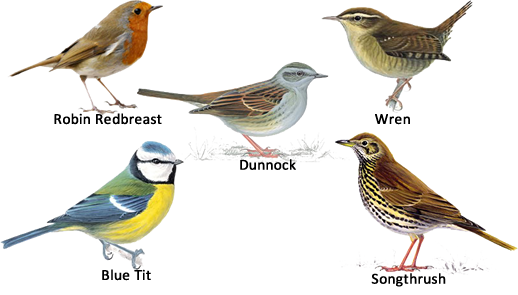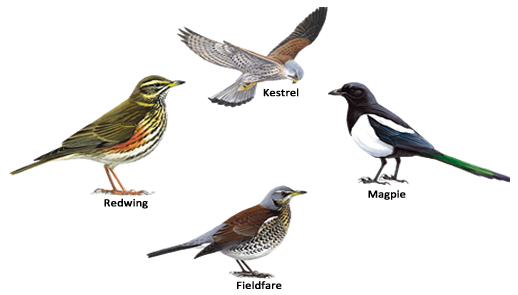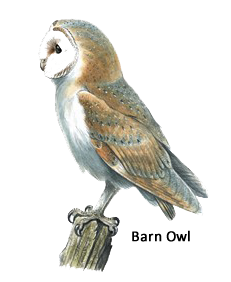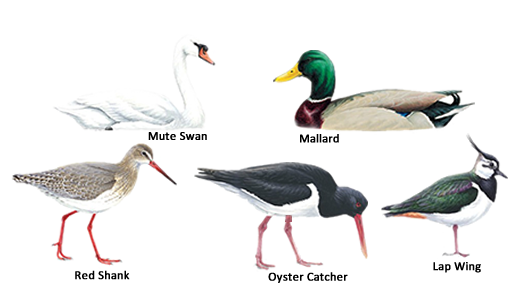Wildlife
BIRDS
ABOUT HABITATS
The two main habitats consist firstly of mixed woodland, some of which has a dense cover of rhododendron, as in park of Billinge Wood, and secondly of farmland, mostly grassland devoted to cattle and sheep grazing.
There are also several small but important wetland habitats, these being along the banks of the river Darwen, the reed-bed in Willow Ground Wood and several ponds, including an ornamental lily-pond and two ponds constructed by the manpower services commission in Willow Ground Field between 1986 and 1988.
Two other small but significant habitats consist of rough grazing, mostly on the yellow hills and healthy areas both here and in Billinge Wood.
WOODLAND, HEDGEROW AND GARDEN BIRDS
Many song Birds live in these places and can often be attracted to bird tables including Blackbird, Song Thrush, Mistle Thrush, Robin, Wren, Dunnock, Blue Tit, Great Tit. Coal Tit and Marsh Tit. Long-Tailed Tits are also common and travel in flocks of up to 12-15 individuals during the winter.
The smallest British bird, the Goldcrest, can often be seen with mixed flocks of tits during the winter.
Several types of finch occur, especially in the more formal areas between the Visitor Centre and the lily-pond. Each is quite distinct to look at and they have distinctive songs.
The Chaffinch is the commonest, the male having a pinkish-red breast and a lively song. The thicker billed Greenfinch has greenish-yellow plumage and a rather monotonous nasal song.
The Goldfinch has a tuneful, almost canary-like song and bright yellow and red colours. All three nest here and form winter flocks when they become more widespread. Two shyer finches to look out for are the Bullfinch with its crimson breast and dark gray back and the elusive Hawfinch, with its remarkable stout bill.
Two quite closely related species are the Redpoll with its red forehead and the Siskin, a winter visitor with yellowish green feathers. Both prefer birch and alder woodland.
In spring-time a number of migrant song birds arrive, the Willow Warbler being easily the commonest. This species is uniformly brown, is very active and the song is an often repeated, musical, liquid and softly descending warble.
Another warbler is the Blackcap, the black head of the male making it easy to identify. The song is a very melodious warble, which can last up to half a minute. The song, however, can be confused with that of Garden Warbler, which is less melodious and in short bursts. It also lacks the black head of the Blackcap.
Other summer visitors to look out for are the much declined Redstart, the Spotted Flycatcher and the Wood Warbler with its distinctive song flight.
Other resident woodland species are Sparrow hawk, Pheasant, the much increased Nuthatch with its blue-grey and pink colouration and a loud, ringing call, the mouse-like Treecreeper, Tree Sparrow, Tawny Owl, Greater and Lesser Spotted Woodpeckers, Wood Pigeon, Collared Dove, the shy Woodcock, a brown wading bird of damp woodland areas, Jay, Rook and Carrion Crow. Rooks nest colonially – there is a rookery near Witton High School – whereas Crows nest singly.
A Wood Pigeon
FARMLAND BIRDS
Some species can be found on farmland at any time and in varying degrees elsewhere for example Magpie and Kestrel. The Kestrel hunts its prey, mostly small mammals, by hovering and watching.
Starlings flock in winter on farmland, and look for food there in springtime when feeding their young.
Some species nest on farmland, for example the Lapwing, with its distinctive tumbling song flight and ‘pee-wit’ call and the Curlew with its musical trilling song flight and down-curved bill.
Other species to look out for in summer are the swallow, hawking for insects, and the now rather rare Yellow Wagtail.
Fieldfare and Redwing are two winter visitors – both thrushes from Scandinavia. The Fieldfare is grey in colour and is slightly smaller than the Mistle Thrush. The Redwing
has chestnut under the wing. Bramblings also occur in winter, often in company with Chaffinches.
Jackdaws can be seen at any time of the year, but you will now be very lucky to see a Barn Owl.
WATER BIRDS
Water habitats encourage many sorts of birds, either on the water itself or in cover on the side of streams, rivers and ponds.
Some species can be seen at any time for example Heron, Mute Swan and usually flying overhead – Canada Geese, which breed not far away. Mallard can be seen, as can the Moorhen with its distinctive red shield on the forehead.
Several species of gull can be seen at most times of the year – Black-headed, Herring, Lesser Black-backed, and common. Greater Black-backed Gulls have also been recorded.
Various ducks and waders occur chiefly in autumn and winter, for example Teal, Pochard, Snipe, Jack Snipe and Redshank. Oystercatchers, however, occur more often in spring and summer. Their black and white plumage and red beaks and legs are unmistakable. Green Sandpipers pass through in autumn.
Some species are summer visitors, for example Common Sandpiper on the river Darwen and Sedge Warbler. Swifts, House Martins and Sand Martins also frequent the river. Particularly in July and August. Other species, which occur, are Reed Bunting, Pied Wagtail, Grey Wagtail and the very shy Water Rail.
BIRDS OF HEATHLAND AND
ROUGH PASTURE
Rather poor for bird life in winter, when the commonest species are the resident Skylark and the Meadow Pipit. Little Owl and Stock Dove are seen occasionally.
These areas come into their own in the spring and summer. It is then that the Linnet can be met with – the male has a splash of red on both breast and crown. Numbers of breeding Yellowhammers have, however, declined substantially.
Summer visitors are both interesting and varied. Ring Ousel and weateater both occur on passage, the latter having nested. Whinchats have also been recorded breeding.
The tree Pipit and Cuckoo have both declined considerably over the years. The Whitethroat still occurs in Pleasington Playing Fields, as does the Lesser Whitethroat.
RARITIES
A fascinating aspect of bird-watching is that there is always the chance of something really unusual turning up – Kittiwake (DEAD), Whimbrel, Red-legged Partridge, Osprey, Black Redstart, Waxwing and Corn Bunting have all been seen in recent years.
OTHER WILDLIFE OF WITTON
ROE DEER
ROE DEAR(Capreolus capreolus) this small graceful deer, reaching 24-28” (61-71 cm) at the shoulder, is the most attractive deer in Britain, delicately built and with an intelligent soft expression; males have short, forked antlers.
The coat is foxy red from May to September but turns dark grey-brown with a white rump patch in winter. Roe deer are common in parts of England and widespread in Scotland, liking plantations and thickets, which are sheltered and dry.
1-3 fawns (but usually twins) are born in May.
Many roe dear are often seen grazing in Witton Country Park on the football fields and roaming around the woods looking for food. Usually if approached by people they run off fast in to the distance but when they are first sighted (before running away) they are so beautiful to look at.
RABBITS
RABBIT(Oryctolagus) smaller and shorter-eared than the hare, reaching about 17” (42 cm), with the very visible feature of the white tail, or scut, the rabbit is a sociable animal which spends most of the daylight hours below ground. Despite myxomotosis, rabbits are still very numerous, and live throughout the British Isles, wherever short grassland occurs.
Renowned for their breeding prowess, a female may produce up to 30 offspring in a year. Its diet is made up of a mixture of grasses, herbs, shrubs and roots.
HARES
BROWN HARE(Lepus capensis) found throughout England and Wales, the brown hare lives a discreet, largely nocturnal life, favoring farmland and rough pasture for its habitat. The brown hare is most often seen during its legendary ‘mad March’ courtship period, when it races, leaps and ‘boxes’ like an animal possessed. Larger than the rabbit, it measures 22” (55 cm), and weighs up to 9 lb (4 kg). Its long, strong legs power it to speeds of about 40 mph. The female produces two to five young from January to October.
FOXES
FOX(Vulpes vulpes) the versatile and adaptable fox is widespread throughout the countryside, occurring in both rural and urban areas. Measuring about 40” (100cm) from its pointed nose to its white tipped bushy tail, the fox is most often seen at dusk as it begins its night-long search for food.
Foxes have a very mixed diet, which includes small mammals, birds and insects. Solitary for much of the year, foxes pair up to mate in winter. They then separate until the 4 or 5 young are born below ground in spring when the male returns to feed the nursing vixen.
GREY SQUIRREL
GREY SQUIRREL(Sciurus carolinensis) Introduced from N.America in 1876, this squirrel has now become firmly established throughout most of England and Wales. Larger than the red squirrel, its head and body measures 9-12” (23-30cm) and the flattened tail a further 8-9 (20-24cm).
In summer the fur may be tinged reddish-yellow feeds on seeds and nuts in autumn and winter but eats thin bark and buds in spring and also avidly eats bird’s eggs and young. 2 litters of 1-7 are reared January-June in domed twiggy ‘dreys’ high in trees.
HEDGEHOGS
HEDGEHOG(Erinaceus europaeus) This spiny-backed 10”(25cm) mammal that rolls into a prickly ball when threatened, is widespread and common in deciduous woodland, hedges, parks and gardens, foraging at night for worms, slugs and insects, Because of the scarcity of food in winter, it hibernates in a thick, hidden nest of dry leaves. Boers and sows associate briefly to mate – the male takes no part in rearing the young.
1 or 2 litters of 4-5 are reared each summer in a larger nest than that used for winter hibernation.
PHEASANT
RING-NECKED PHEASANT
(Phasianus colchicus ssp. Torquatus) This subspecies is found in eastern China and was brought to Britain in the 1700s to improve the existing stock for sporting purposes. Males have a white ring around the neck, a blue-grey rump and upper tail converts.
Female birds are darker and more heavily patterned than those of other subspecies.
The behaviour and breeding habits are the same as those of common pheasant. 7-15 olive-brown eggs are laid April-June.
Males have harems and hens rear the chicks alone.
FARM ANIMALS
There are quite a lot of animals in the farmland of Witton Country Park, the most typical ones you will find are cows, sheep, hens and chickens but here we can see many other types to like horses, llamas and donkeys, not to mention ostrich’s on a nearby farm also.
Baby donkey (left) and Farm Sheep and baby (right)






